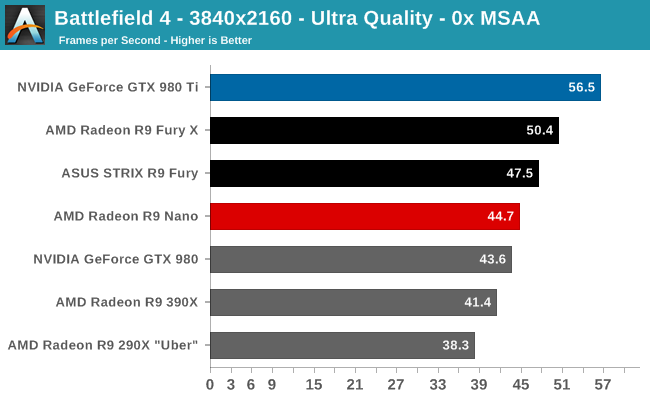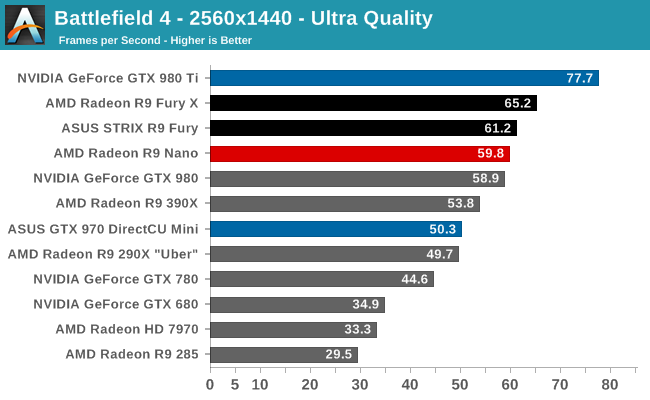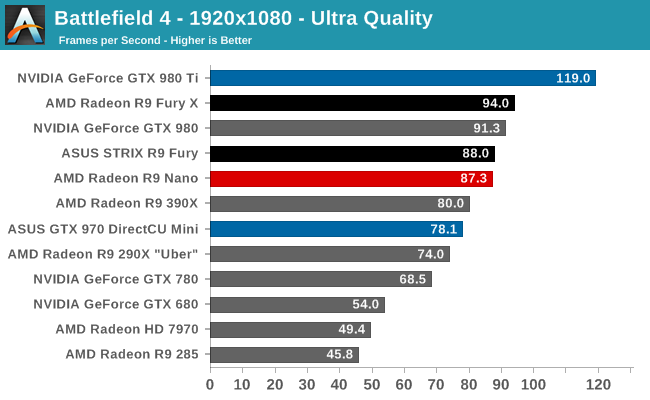The AMD Radeon R9 Nano Review: The Power of Size
by Ryan Smith on September 10, 2015 8:00 AM ESTBattlefield 4
Kicking off our benchmark suite is Battlefield 4, DICE’s 2013 multiplayer military shooter. After a rocky start, Battlefield 4 has since become a challenging game in its own right and a showcase title for low-level graphics APIs. As these benchmarks are from single player mode, based on our experiences our rule of thumb here is that multiplayer framerates will dip to half our single player framerates, which means a card needs to be able to average at least 60fps if it’s to be able to hold up in multiplayer.




Like the other Fiji cards, AMD is promoting the R9 Nano in part on its 4K capabilities. And while we disagree that this card is suitable for 4K gaming based on its sub-Fury performance, we’re including 4K results anyhow to serve as a point of comparison.
In any case Battlefield 4 is often a good indicator of general card performance, and for the R9 Nano this is no exception. What we find is that the R9 Nano trails the other Fury cards in all cases. However to our initial surprise, the R9 Nano sticks rather close to the R9 Fury. The petite powerhouse trails the R9 Fury by only 1-6%, which for the record is a smaller gap than we were expecting.
While the R9 Nano packs a full Fiji GPU, AMD has to pull back on clockspeeds to hit their power targets; in the case of Battlefield 4 this is an average clockspeed of just 879MHz at 2560x1440. Given this we had been expecting the R9 Nano to deliver around 85-90% of the performance of the R9 Fury (and about 80% of the R9 Fury X), based on the assumption that average clockspeeds would be closer to 800MHz. So the fact that the R9 Nano starts off as close to the R9 Fury as it does – even if it’s still trailing it – is a pleasant surprise.
Otherwise with performance still clearly occupying a position as a “3rd tier” Fiji card, I’m not sure if anything about these results should be surprising. On a price/performance basis AMD is not intending to be competitive with other $650 cards, so the R9 Fury X and GTX 980 Ti are of course on the top of the heap. What you get instead is a card that delivers around 90% of R9 Fury X’s performance in BF4 with much less power consumption.
Moving on, compared to the lower power and smaller cards, the R9 Nano is as expected a clean sweep. Demonstrating the virtues of a wide and lower clocked processor’s ability to deliver strong performance without requiring extreme power, everything from the R9 285 to the GTX 980 trails the R9 Nano here. Compared to the GTX 970 Mini in particular, the R9 Nano is 12-26% faster depending on the resolution.
The one potential problem here for the R9 Nano is the GTX 980. Though not a Mini-ITX card, the GTX 980’s power consumption is going to be fairly close to the R9 Nano’s, definitely more so than GTX 970’s. From a power efficiency standpoint it’s the GTX 980 that poses the greatest challenge to the R9 Nano, and while it’s ahead of the GTX 980 in this case at 2560x1440 and higher, it’s a sign that AMD should be worried about what could happen if an NVIDIA partner produced a Mini-ITX GTX 980.










284 Comments
View All Comments
anubis44 - Thursday, October 8, 2015 - link
"you forgot to include evidence of them lying, or a reason for why they would lie."Are you for real? Evidence of misrepresentation is that the box says '4GB', and you can only practically use 3.5GB of the 4GB in a game, or the performance will tank. How much more evidence do you require?
As for a reason why they would do this? You've got to be joking. $$! That's why. The memory controller they used to make a '4GB' card was cheaper than one that would have run all the memory at full speed. That would likely have pushed the price of the card well above $400, and outside of the targeted dupe market of $350-$400. The cheaper, gimped memory controller also meant that nVidia made more profit per card. They just hoped nobody would catch their use of a gimped memory controller before they'd ripped off tens of thousands of slavishly loyal nVidiots who all mindlessly rushed out to computer stores to plunk down their money. And it worked. Tens of thousands have plunked down their money, and nVidia has posted better than ever earnings. What a surprise.
anubis44 - Thursday, October 8, 2015 - link
HA HA HA! An 'honest' mistake? Give me a break! Are you saying nVidia just didn't realize that the cheap memory controller they saddled the GTX970 had a flaw? Yeah, right. They just didn't know that the last .5GB of memory would be gimped by running it at 1/7 the speed of the other 3.5GB. And of course, the decision to use that cheaper memory controller didn't have ANYTHING to do with padding their already fat profit margins at the expense of their customers. Meanwhile, they have the audacity to print '4GB Ram' on all the boxes. As if nVidia just didn't realize that tens of thousands of nVidiots wouldn't go out and buy the cards for a few months before an independent reviewer finally caught them in the act. nVidia is as guilty as a cat in a goldfish bowl, and if you're going to pretend that this whole fiasco was 'handled admirably' by nVidia, then you must really be a fan of Jen Hsun. Seriously, at least have the self-respect to call a spade a spade and admit that nVidia tried to pull a fast one just to line their pockets and got caught.SolMiester - Thursday, September 10, 2015 - link
Oh please, its already been stated that you have to load up beyond normal use before the .5Gb ram comes into play and for the majority or users at 1080, its doesnt effect them.RussianSensation - Thursday, September 10, 2015 - link
@SolMeiser, 1080P is fine but some gamers who purchased GTX970 did so for their 2560x1440/1600 monitors, in addition to others who bought GTX970 SLI. Also, even if in the majority of games the 3.5GB RAM isn't an issue, it's how NV responded to the situation is what's telling.Kutark - Thursday, September 10, 2015 - link
So, what do you have to say about all the dubious shit AMD said during the pre fiji release? They claimed several times it was the fastest card in the world, when it wasn't, and they KNEW it wasn't.I'm tired of people being inconsistent, if you're going to point out questionable behavior in one company then you have to do it for the other.
silverblue - Friday, September 11, 2015 - link
They could've run benchmarks well before the launch, and then fallen behind once NVIDIA had brought out new drivers, or they could've straight out lied. What I'd like to see is AMD's 4K Gaming Performance Benchmarks bar chart scrutinised for every game to see how far out of reality the results were with the setups that were used, then we can be 100% sure (after all, Fiji is more competitive at 4K than lower resolutions).fuicharles - Friday, September 11, 2015 - link
Not giving a review copies to certain reviewer is worse or the one who create gameworks is worse ?Horza - Thursday, September 10, 2015 - link
Thank you for being the impartial voice of reason Wreckage. I've always enjoyed your measured and balanced approach to assessing the merits of the two big dGPU players. Your attack on Anandtech's credibility holds so much more weight coming from a person with a track record of non-partisan, unbiased viewpoints such as yourself. Thank you again.ingwe - Thursday, September 10, 2015 - link
If you read the final words, I think this is a very fair review. To me it says: "This is better than usual form AMD, but it isn't enough and it is too expensive." Seems accurate and unbiased.bill.rookard - Thursday, September 10, 2015 - link
Actually, I do find it 'enough', it -is- a very good, supremely capable card that comes in at 2/3 of the size with 90% of the performance. Heck, it's faster than the GTX 980. My problem? It is too expensive. I know that prime Fiji chips are in short supply at the moment, but it needs to be about $200 cheaper.If they can get their supply running smoothly and get their yields of the full-fat Fiji up, drop the price to about GTX 980 levels they'd never be able to keep them in stock.